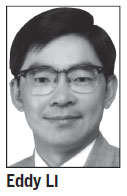Apparel industry should further tap mainland market
Updated: 2012-11-29 13:33
By Eddy Li from Hong Kong (China Daily)
|
||||||||
|
 |
Weeks ago I wrote an article about the feasibility of a Hong Kong wholesale market, in which I mentioned five potential categories of markets, including apparel and textiles in Cheung Sha Wan, jewelry in Hung Hom, electronics in Sham Shui Po, miscellaneous goods in Kwun Tong, and furnishings in Wong Chuk Hang.
Of these five industries, the apparel industry seems to have the most mature conditions. Since the middle of the last century, Hong Kong began transforming from a re-export commercial port into an industrial city of export, and the apparel industry played an indispensable role in leading the industrialization of the city. Besides, garments have always been an important part of our export.
The development of the apparel industry depends greatly on consumption in the target market. Developed countries in Europe and Japan haven't yet recovered from the global financial crisis and the macroeconomic environment is fatigued and weak. These countries don't encourage consumption, and consumers hold a cautious disposition when buying. In comparison, the emerging markets, where the demand is increasing, are unprecedentedly important.
The Chinese mainland for a long-time has been the major trading partner to Hong Kong and the biggest market among the emerging ones. That market is definitely worthy of serious consideration. Actually, the HK government has already noticed this. It has invested many resources researching and studying industrial consumption. These surveys, which have practical values for economic development, need only one more step to be promoted to the public, so that the resources are effectively utilized.
Last month, HKTDC published a research report named "The apparel consumption in China's main cities". There were more than 3,000 respondents from 13 main cities in the survey, including major apparel consumers, such as people in employment, housewives and students.
Based on the model of 4P (product, price, place and promotion) in marketing, the report also gives some suggestions. Generally speaking, the products and pricing of Hong Kong brands need no significant modifications, but there is still much to do with regards to place and promotion. According to the report, in the previous 12 months, respondents had an average expenditure on apparel of 2,635 yuan ($423) and plan to spend 3,616 yuan on clothing in the coming year. The average growth of nearly 1,000 yuan is considerable, reflecting that the mainland market has not yet reached its saturation point. The seller's market, in which demand exceeds supply, still predominates.
The increase in demand for apparel is especially obvious in northern cities. On one hand, economic development in the north has generally come after the south, so at the moment, the north has greater potential and the living standard there is improving more rapidly. On the other hand, the report shows that the cold weather expedites increases in average apparel consumption.
The research also reveals that the respondents are willing to pay 58 percent more as a premium. In purchasing mid-priced clothes, Hong Kong brands are their first choice. In some real experiences, however, we can find that only a few of the numerous Hong Kong brands are familiar to the public. In neighboring Guangdong province, many brand names have already won many regular customers. But in other places especially the north, the brands remain unfamiliar to consumers. The northern market, therefore, is worthy of developing, and the space is huge.
Local brands are equipped with full-blown marketing strategies and promoting measure; they now need to build their reputations and recognitions to permeate through other cities. Preferences of promoting and placing in different cities in the report are good references. For example, we can strengthen vocational training in areas other than the north, where consumers take staff services seriously; and we can add tailoring services in the north because people there care about the fitness the most. To different degrees, we can improve and modify the suggestions accordingly, so that the Hong Kong brands can be successfully implanted into the market.
The author is vice-president of the Chinese Manufacturers' Association of Hong Kong.

 Relief reaches isolated village
Relief reaches isolated village
 Rainfall poses new threats to quake-hit region
Rainfall poses new threats to quake-hit region
 Funerals begin for Boston bombing victims
Funerals begin for Boston bombing victims
 Quake takeaway from China's Air Force
Quake takeaway from China's Air Force
 Obama celebrates young inventors at science fair
Obama celebrates young inventors at science fair
 Earth Day marked around the world
Earth Day marked around the world
 Volunteer team helping students find sense of normalcy
Volunteer team helping students find sense of normalcy
 Ethnic groups quick to join rescue efforts
Ethnic groups quick to join rescue efforts
Most Viewed
Editor's Picks

|

|

|

|

|

|
Today's Top News
Health new priority for quake zone
Xi meets US top military officer
Japan's boats driven out of Diaoyu
China mulls online shopping legislation
Bird flu death toll rises to 22
Putin appoints new ambassador to China
Japanese ships blocked from Diaoyu Islands
Inspired by Guan, more Chinese pick up golf
US Weekly

|

|






